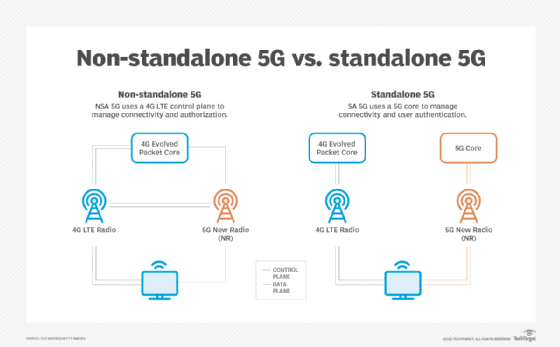5G NSA vs. SA: How do the deployment modes differ?
As 5G continues to mature, technology leaders must weigh NSA's lower cost and faster rollout against SA's latency, efficiency and long-term ROI to guide their network investment strategy.
No longer in its infancy, 5G is expanding its coverage across the U.S. as mobile network operators (MNOs) ramp up their deployments.
MNOs have two primary methods for deploying 5G. The first is non-standalone (NSA) 5G, where a 5G radio access network (RAN) operates on a legacy 4G LTE core. The second is standalone (SA) 5G, which is built on top of a 5G RAN and a cloud-native 5G core.
Both NSA and SA use the 5G New Radio (5G NR) interface. This enables each architecture to deliver features and capabilities based on the standards defined by the 3rd Generation Partnership Project (3GPP). 5G NR offers numerous use cases, but one of its most significant benefits is facilitating a seamless transition from 4G LTE to 5G.
Initial MNO 5G deployments relied on NSA because it could use existing cellular networks. But, as SA 5G deployments take off, it's essential to understand the distinction between NSA and SA. Both approaches are valid, but the efficiency of a 5G network depends on the mode that MNOs select.
Non-standalone 5G
For NSA 5G, the clue is in the name: It's 5G that can't stand on its own in terms of infrastructure. NSA is a 5G RAN that operates on a legacy 4G LTE core, known as Evolved Packet Core (EPC), and manages control plane functions. NSA includes a 4G and 5G base station, but the 4G base station takes precedence. Because the NR control plane anchors to the EPC, radio frequency signals are forwarded to the primary 4G base station.
NSA 5G, also known as Release 15 by 3GPP, is considered the first stage of 5G. Initial 5G deployments relied on NSA because MNOs with 4G LTE networks could implement a 5G RAN on their existing infrastructure to build a 5G network. NSA 5G can serve as a stepping stone for carriers unprepared to make a hefty investment when transitioning from legacy 4G LTE to 5G networks.
However, NSA 5G can't deliver the specific features and capabilities offered by a natively built SA 5G network. Ultra-low latency, a hallmark of 5G, isn't enabled by NSA networks. Another disadvantage of NSA is that it isn't as energy efficient as SA; 5G networks underpinned by 4G infrastructure require more power. Although 5G NR is more energy-efficient than LTE, using two different forms of cellular technology can massively increase power consumption.
NSA 5G shouldn't be confused with dynamic spectrum sharing (DSS), another method for deploying 5G using 4G technology. While NSA creates a 5G network using 4G infrastructure with dual connectivity, DSS permits 4G LTE and 5G NR to coexist in the same frequency band. 5G networks have a variety of spectrum bands available for use, and DSS distributes spectrum between bands based on user demand.
Benefits of NSA 5G
NSA 5G presents several advantages, including the following:
- Reduced costs. MNOs can build a 5G network on top of their existing 4G infrastructure rather than investing in a new, costly 5G core.
- Easy deployment. NSA networks use 4G infrastructure with which MNOs are already familiar, simplifying configuration and update processes.
- Fast rollout. MNOs can release an operational 5G network more quickly than with NSA by using 4G infrastructure.
- Pathway to SA 5G. MNOs configured NSA 5G networks as a foundation while SA networks were being developed. As SA networks roll out, carriers can replace outdated 4G network elements with 5G infrastructure to manage their existing 5G networks.

Standalone 5G
SA 5G networks, with their 5G RAN and cloud-native 5G core, support essential 5G functions and other advantages, including reduced latency, improved network performance and the ability to control network management functions with a central controller.
SA requires MNOs to configure and learn an entirely new architecture. As carriers waited for SA technology to mature, most opted for a more convenient and less expensive route by reconfiguring their 4G networks to support 5G.
New providers without established 4G core networks, however, couldn't follow that strategy. Because they couldn't rely on a 4G core, they needed to build their 5G infrastructure from scratch. As more MNOs seek to take advantage of the benefits SA offers over NSA, that architecture could soon become the dominant one.
The most significant disadvantage of SA is that it's costly to implement and time-consuming for network professionals to learn the new 5G core infrastructure. Regardless, MNOs will likely shift to SA because, while NSA can serve as a step toward 5G networking, it isn't considered true 5G due to its reliance on 4G LTE.
Benefits of SA 5G
SA 5G advantages include the following:
- Reduced power consumption. Because SA doesn't operate with 4G LTE, it uses only one cellular connectivity method, which consumes less power to support the network.
- More 5G use case support. Unlike NSA, SA can deliver essential 5G services and features, such as improved latency and increased bandwidth caps, to power ultra-fast, scalable networks.
NSA vs. SA: 5G NR specifications
Ultimately, the biggest difference between NSA and SA is how each mode transmits 5G. NSA uses a 5G RAN and a 4G LTE core, while SA is an end-to-end 5G network with a 5G RAN and a 5G NR core. Their methods of deployment determine how each mode supports the 3GPP-defined NR specifications.
5G NR specifications target three key areas:
- Enhanced mobile broadband. Functioning as an extension of 4G, this increases data rates to improve network speeds.
- Massive machine-type communications. These connect up to 1 million devices and facilitate quick, seamless communication.
- Ultra-reliable, low-latency communications. These ensure network reliability by reducing latency to below 5 milliseconds.
Various industries and services aim to benefit from these features, including emerging sectors such as IoT and satellite communications. But only NSA 5G -- because of its more powerful and flexible 5G core -- can natively support these capabilities. NSA 5G, by contrast, can enhance mobile broadband because the 4G core can be extended to support that specification.
MNOs remain committed to SA 5G, but a sputtering global economy has pumped the brakes on the widespread deployments carriers promised years ago. MNOs are also finding that 5G ROI is more elusive than anticipated. Because carriers have yet to see many lucrative or killer applications that justify the transition to SA 5G, NSA currently reigns supreme.
Yet, research suggests that MNOs mulling a move to SA 5G shouldn't sit on the sidelines too long. Carriers adopting SA 5G could reap financial benefits from its advanced capabilities, thereby easing ROI concerns. NSA might be easier to manage and less expensive than SA, but carriers that want to exploit SA's most beneficial and anticipated capabilities should make their moves sooner rather than later.
Editor's note: This article was updated to improve the reader experience.
Deanna Darah is site editor for Informa TechTarget's SearchNetworking site.







